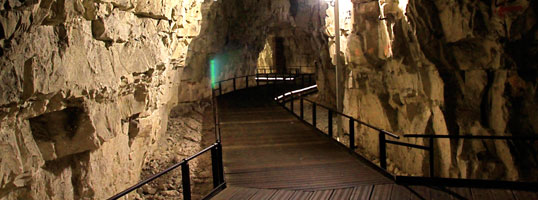1 UNDERGROUND WORLD Specialist tunneling companies dug subterranean trenches across much of the Western Front, such as those preserved in the Wellington Quarry beneath Arras in northeastern France. The mine tunnels were among the most ambitious of all.
2 BIG BANG A rare photograph captures the explosion of the mine under Hawthorn Ridge Redoubt, packed with 18 tons of explosives, at the beginning of the Battle of the Somme in June 1916.
3 LASTING IMPACT The 24-ton Lochnagar Mine, detonated at the beginning of the Battle of the Somme, left behind a crater some 91 meters (300 ft) across and 21 meters (70 ft) deep, which has been preserved in commemoration of the battle
LOCATION West Flanders, Belgium
NEAREST POPULATION HUB Ghent
SECRECY OVERVIEW Access restricted: home to the First World War’s largest unexploded mine.
La Basse Cour (which translates as “The Farmyard”) is a 60-hectare (150-acre) privately owned farm close to the town of Ypres. Amid the push-and-pull of the First World War’s Western Front, its location on the Messines Ridge put it on the front line of hostilities. Today the farm sits on a massive 22,500-kilogram (50,000-lb) mine that has yet to detonate.
The Messines Ridge fell under German control in the early months of the First World War, and remained so until 1917. It was a major target for British forces stationed in the area and, as it became increasingly clear that trench warfare was producing only stalemate, a radical new plan was put into action.
From January 1916, British troops began digging underground tunnels from their lines around the Ypres Salient toward the German encampments at Messines. The idea was to lay a series of mines that could be exploded shortly before a major troop offensive. In fact, the scheme was put on hold until 1917, when 25 mines and 450,000 kilograms (1 million lb) of explosives were laid underground along an 11-kilometer (7-mile) front after a heroic period of subterranean burrowing.
British forces under the command of General Sir Herbert Plumer began a heavy bombardment of German positions toward the end of May 1917. On June 7, Plumer gave the order to detonate the mines, creating a blast that claimed between 6,000 and 10,000 enemy lives and which was reputedly loud enough to be heard in London. Within a week, the British had secured the Messines Ridge.
However, six of the British mines survived the operation intact. Five of them were left undetonated for strategic reasons, while the sixth was lost during a German counter-mining attack and never recovered. It lay beneath a farm then known as Le Petite Douve, which was renamed as La Basse Cour by its owners, the Mahieu family, in the aftermath of the conflict.
And there the mine survives to the present day. While another of the Messines mines exploded spontaneously in 1955 during a lightning storm, the bomb beneath La Basse Cour remains buried some 24 meters (80 ft) beneath the Mahieus’ property. Its exact location was pinpointed in the 1990s by British researchers using historical maps of the area, but only the foolhardy are likely to want to prod and poke at this sleeping but potentially deadly brute.
